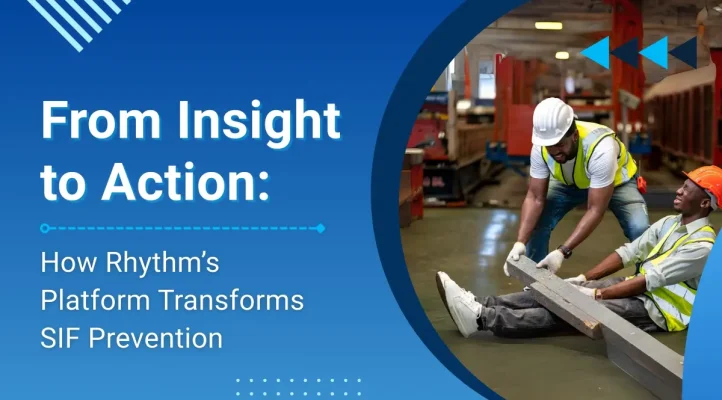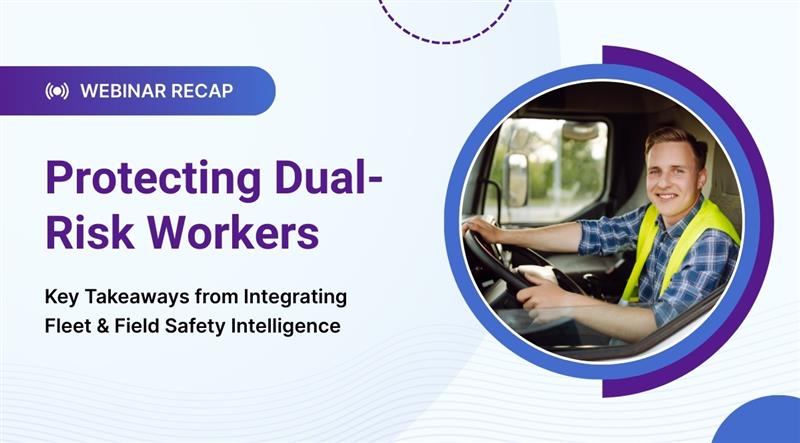From Insight to Action: How Rhythm Transforms SIF Prevention

WHY SERIOUS INJURIES AND FATALITIES CONTINUE TO DEFY TRADITIONAL SAFETY METRICS
Organizations across high‑hazard sectors have made major strides in reducing overall incident rates, yet the trend for serious injuries and fatalities (SIFs) tells a very different story. An analysis of more than 94,000 recordable incidents from over 50,000 U.S. contractor companies found 20,023 SIF cases and 677 deaths and contact with objects or equipment caused more than 40 % of those SIF events[1]. U.S. Bureau of Labor Statistics data for 2023 still recorded 5,283 fatal work injuries, equating to 3.5 deaths per 100,000 full‑time‑equivalent workers[2].
While minor incidents have fallen, research shows that SIF rates decline much more slowly than non‑critical injuries[3]. Simply reducing incident frequency does not proportionally reduce SIF frequency; focusing only on reported SIFs overlooks thousands of “close calls” that contain crucial warning signs[3].

Why the disconnect? Safety experts now agree that SIFs have different root causes than minor injuries. Analyses of Heinrich’s accident pyramid show that the behaviors or “unsafe acts” at the base do not necessarily cause the fatalities and major injuries at the top[4]. Thomas Carson notes that root causes of serious incidents are so different from those of minor injuries that focusing on minor events may divert attention from preventing SIFs[5]. Traditional lagging indicators like Total Recordable Incident Rate (TRIR) or OSHA logs describe what has already happened; they offer little insight into potential serious injury/fatality (pSIF) events that almost happened but did not result in harm[3].
UNCOVERING PSIFS: THE KEY TO PROACTIVE PREVENTION
To truly reduce SIF exposure, organizations must identify potential serious injury or fatality (pSIF)events. These are unplanned events or exposures that could have led to a serious injury or fatality under slightly different circumstances. They aren’t just near misses; they include routine tasks or hazards whose catastrophic potential is often underestimated. Focusing on pSIFs unlocks hidden risk factors: instead of documenting what almost happened, pSIF frameworks use analytics to identify high‑risk patterns and precursors and intervene before an incident occurs[6].
Identifying pSIFs is challenging. Manual classification requires experts to review every incident report, an impractical task for most organizations. Researchers have therefore been exploring automation: Parikh, Penfield and Juaire (2024) showed that machine‑learning models can classify incident reports for pSIF exposure, highlighting that SIF rates decline more slowly than minor incidents and that pSIF identification is essential[3]. The pSIF metrics surface risks before they cause harm and that subjective definitions of “potential” can be made more consistent through data and collaboration.
FROM REACTIVE DATA TO PREDICTIVE INTELLIGENCE: RHYTHM’S APPROACH
Rhythm’s Worker Risk Command Center™ addresses the SIF challenge by integrating data, analytics and collaboration across different risk domains. The platform bridges the gaps that cause SIFs to persist:
-
Unified Risk Signals:
The Command Center pulls incident reports, behavioral observations, inspections, maintenance data and training records into a single view, giving leaders holistic visibility of emerging risks. This cross‑functional integration mirrors modern research on predictive modelling, which combines historical incident data, environmental factors, equipment performance, worker behavior analytics and external influences to build a comprehensive risk picture[7].
-
Predictive Analytics:
Using AI and machine learning, Rhythm identifies leading indicators and patterns associated with SIFs. Predictive models tap into structured and unstructured data to flag high‑risk conditions, recommend interventions and continuously learn. For example, AI‑driven video analytics can detect unsafe load swings, worker proximity to moving equipment or repeated bypassing of machine guards; in real‑world deployments such predictive monitoring has reduced high‑risk proximity events by more than 60 % within six weeks[6]. Through risk scoring and pSIF identification, the platform prioritises issues that warrant immediate action, ensuring resources focus on what matters most[6].
-
Real‑Time Alerts and Escalations:
Instead of waiting for weekly reports, Rhythm delivers role‑based notifications when pSIF thresholds are exceeded or critical controls are compromised. Alerts can trigger permit suspensions, equipment shutdowns or workflow changes. Case studies in predictive safety illustrate the impact: AI‑driven monitoring in a Malaysian manufacturing plant reduced violations of machine‑guard rules by 62 % within weeks, while a UAE oil‑and‑gas site achieved a 40 % drop in incidents after redesigning traffic flow based on predictive insights[6].
-
Closed‑Loop Accountability:
Once a risk is flagged, the platform assigns corrective actions, tracks status and verifies completion. This ensures that identified pSIFs translate into concrete improvements rather than lingering as unresolved observations.
-
Compliance and Audit Readiness:
Rhythm maintains a comprehensive audit trail of risk assessments, interventions and training outcomes. With SIF-related regulations tightening worldwide, having an automated history of actions and compliance evidence simplifies reporting and supports due diligence.
MEASURABLE OUTCOMES AND BUSINESS VALUE
The move from lagging indicators to predictive intelligence yields tangible results. In research and industry trials:
- Organizations using predictive safety programs have achieved double‑digit reductions in SIF exposure within months. One case cited a 30 % drop in SIF exposure after 90 days by increasing visibility and acting early.
- Predictive pSIF monitoring enables risk prioritisation and behavioral change. Real‑time alerts condition workers to modify unsafe behaviors; targeted training based on individual risk profiles improves engagement and retention[6].
- Integrating pSIF data into contractor evaluations allows companies to reward safe partners and phase out high‑risk collaborators. A construction company improved subcontractor compliance scores by 33% using predictive risk scoring[6].
- The return on prevention is quantifiable: one mining firm estimated that predictive safety interventions avoided US$2.1 million in project‑delay losses in a single year[6].
CONCLUSION: BUILDING A PREVENTION‑FIRST CULTURE
Reducing serious injuries and fatalities demands more than compliance checklists or retrospective metrics. Evidence from multiple industries shows that SIFs often originate from causes distinct from those of minor injuries, and that lagging indicators fail to highlight pSIF events[5][3]. To make workplaces safer, organizations must adopt proactive, data‑driven strategies that surface potential high‑severity events before anyone gets hurt.
Rhythm’s platform exemplifies this shift. By consolidating diverse safety signals, employing AI to detect patterns and pSIFs, delivering real‑time alerts and ensuring accountability, Rhythm helps safety leaders move from insight to action. The result is a prevention‑first safety culture where every signal is captured, every risk is prioritised and every team is aligned – ultimately transforming SIF prevention from a reactive obligation into a strategic advantage.
References
- New White Paper Looks at Serious Injuries, Fatalities from 2017 to 2021 — Occupational Health & Safety
- IIF Economic News Releases: U.S. Bureau of Labor Statistics
- Automatic identification of incidents involving potential serious injuries and fatalities (PSIF) – PMC
- SIFs, PSIFs, and Preventing SIFs
- Revisiting Heinrich and His Triangle
- From Near Misses to Predictive Insights: Potential Serious Injury or Fatality (pSIF)
- Predictive Modeling: The Future of Workplace Safety Management: Risk & Insurance




